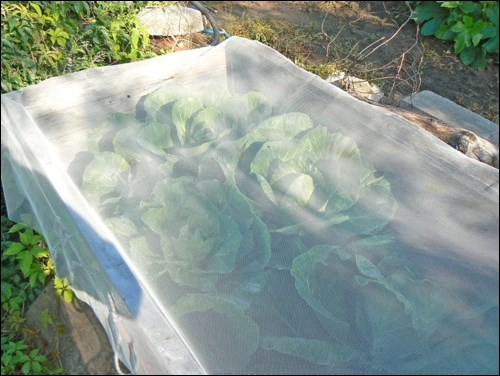Most insect pests crawl, walk or fly to work. If you can interrupt their commute or make it more difficult with a barrier, they may not arrive, leaving your produce unmolested.
Barriers come in many forms. They are easy to use, non-toxic and some are reusable. They are excellent alternative tools in our efforts to reduce using synthetic pesticide. To maximize their effectiveness, it’s helpful to know your pest, its lifecycle, how it moves about and food preferences.
Row covers are one of the easiest and most popular barriers. They prevent mobile insects from landing and eating your fruits and vegetables, or from depositing eggs that eventually develop into larvae that will eat your produce.
Row covers are made of lightweight synthetic fabric and are available in various lengths and widths. They are impenetrable to insects, but they let light, air and water through. Cover plants that have a history of being attacked by insect pests right after seeding or transplanting and leave in place until harvest. Firmly secure the edges of the row cover with soil, boards, rocks, rebar or whatever is handy. It’s critical that insect pests cannot crawl under the cover.
Row covers are effective against:
• white butterflies (imported cabbageworm) that lay their eggs on cabbage, kale, broccoli, cauliflower, Brussels sprouts, kohlrabi and other cole crops;
• onion maggot flies that lay their eggs at the base of onions;
• asparagus beetles that eat the spears as they emerge from the soil;
• Colorado potato beetles that can decimate your potato plants; and
• flea beetles that consume plants in the cabbage family.
Do not use row covers on peppers. The constant movement in the wind is enough to gently rub off your plant’s growing points reducing flowers and fruits.
Very fine mesh netting prevents insects from eating or laying eggs on dwarf fruit trees and bushes. Ensure that the mesh size you select is suitable as some of these insects are small.
Fine mesh netting is effective against:
• cherry fruit fly, an occasional pest of dwarf sour cherries;
• apple maggot on apple trees;
• currant fruit fly on currants and gooseberries;
• saskatoon bud moths and saskatoon sawflies on saskatoon berries; and
• tarnished plant bugs (lygus bug) that attack raspberries, saskatoons and strawberries
Check row covers and netting periodically for holes. When not in use, store them in a dry place, out of sunlight. Most should last for a few growing seasons.
Snagged pantyhose, with their flexible nature, allows for expansion as vegetables develop. If the European corn borer has been a problem, cover developing ears to prevent entry.
Place plant collars (purchased or homemade) around individual transplants to prevent cutworm damage. Collars should be wide enough to contain the young plant without crowding it, and tall enough to be inserted five centimetres into the soil with 15 ccentimetres above the soil. Juice cans, coffee cans or milk cartons (with their tops and bottoms removed) are suitable options.
Tarps or mats placed under fruit bushes prevent larvae (that develop in the fruit and then fall to the ground still within the fruit) from entering or leaving the soil, thus interrupting their life cycle. This is widely practiced in Europe.
Mats for individual vegetable transplants can be about 20 centimetres square with a diagonal cut made from the edge to the centre where the stem comes through. Lay them flat around the stems of susceptible plants. Commercially available mulch rolls, made from fabric, recycled paper or other products, can be cut to size as required. Homemade mats can be made of heavy paper or rubber carpet underlay.
Tarps and mats are effective against:
• cherry fruit fly - place on the soil in early spring to prevent the adults from emerging;
• fruit gall midge - lay tarps below bushes in early July to interrupt pupation; and
• onion maggot flies – at planting to prevent eggs laid at the base of onions, garlic, leeks, shallots
Sara is the author of Creating the Prairie Xeriscape, and, with Hugh Skinner, Gardening Naturally; Trees and Shrubs for the Prairies, and Groundcovers & Vines for the Prairies. Expect Fruit for Northern Gardens with Bob Bors in November, 2017.
— This column is provided courtesy of the Saskatchewan Perennial Society (www.saskperennial.ca; hortscene@yahoo.com; www.facebook.com/saskperennial). Check out our Bulletin Board or Calendar for upcoming garden information sessions, workshops, tours and other events.



